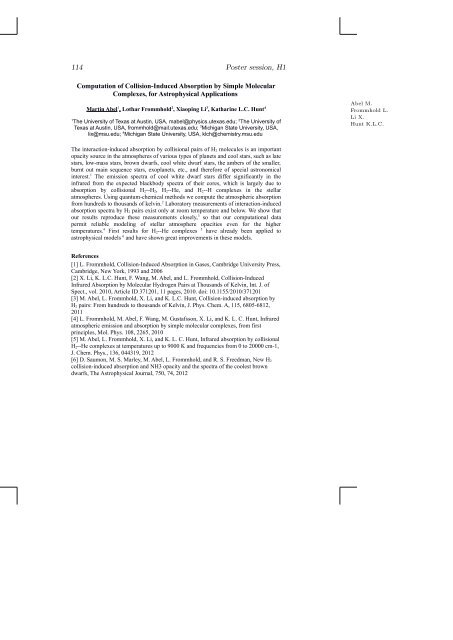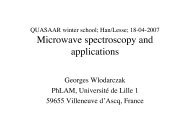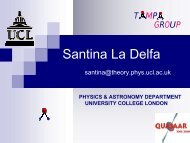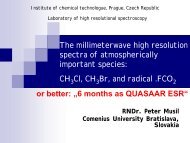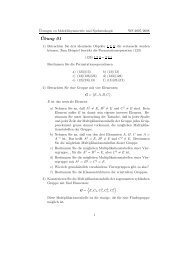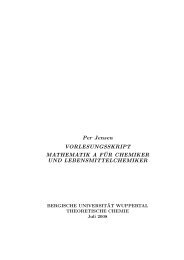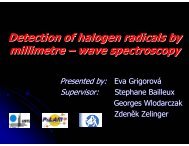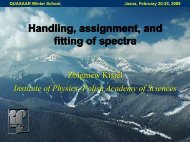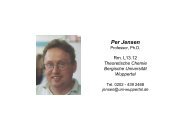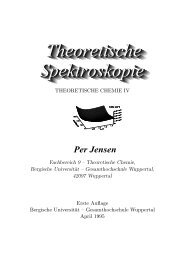114 Poster session, H1Computation of Collision-Induced Absorption by Simple MolecularComplexes, for Astrophysical ApplicationsMartin Abel 1 , Lothar Frommhold 2 , Xiaoping Li 3 , Katharine L.C. Hunt 41The University of Texas at Austin, USA, mabel@physics.utexas.edu; 2 The University ofTexas at Austin, USA, frommhold@mail.utexas.edu; 3 Michigan State University, USA,lix@msu.edu; 4 Michigan State University, USA, klch@chemistry.msu.eduAbel M.Frommhold L.Li X.Hunt K.L.C.The interaction-induced absorption by collisional pairs of H 2 molecules is an importantopacity source in the atmospheres of various types of planets and cool stars, such as latestars, low-mass stars, brown dwarfs, cool white dwarf stars, the ambers of the smaller,burnt out main sequence stars, exoplanets, etc., and therefore of special astronomicalinterest. 1 The emission spectra of cool white dwarf stars differ significantly in theinfrared from the expected blackbody spectra of their cores, which is largely due toabsorption by collisional H 2--H 2, H 2--He, and H 2--H complexes in the stellaratmospheres. Using quantum-chemical methods we compute the atmospheric absorptionfrom hundreds to thousands of kelvin. 2 Laboratory measurements of interaction-inducedabsorption spectra by H 2 pairs exist only at room temperature and below. We show thatour results reproduce these measurements closely, 3 so that our computational datapermit reliable modeling of stellar atmosphere opacities even for the highertemperatures. 4 First results for H 2--He complexes 5 have already been applied toastrophysical models 6 and have shown great improvements in these models.References[1] L. Frommhold, Collision-Induced Absorption in Gases, Cambridge University Press,Cambridge, New York, 1993 and 2006[2] X. Li, K. L.C. Hunt, F. Wang, M. Abel, and L. Frommhold, Collision-InducedInfrared Absorption by Molecular Hydrogen Pairs at Thousands of Kelvin, Int. J. ofSpect., vol. 2010, Article ID 371201, 11 pages, 2010. doi: 10.1155/2010/371201[3] M. Abel, L. Frommhold, X. Li, and K. L.C. Hunt, Collision-induced absorption byH 2 pairs: From hundreds to thousands of Kelvin, J. <strong>Ph</strong>ys. Chem. A, 115, 6805-6812,2011[4] L. Frommhold, M. Abel, F. Wang, M. Gustafsson, X. Li, and K. L. C. Hunt, Infraredatmospheric emission and absorption by simple molecular complexes, from firstprinciples, Mol. <strong>Ph</strong>ys. 108, 2265, 2010[5] M. Abel, L. Frommhold, X. Li, and K. L. C. Hunt, Infrared absorption by collisionalH 2--He complexes at temperatures up to 9000 K and frequencies from 0 to 20000 cm-1,J. Chem. <strong>Ph</strong>ys., 136, 044319, 2012[6] D. Saumon, M. S. Marley, M. Abel, L. Frommhold, and R. S. Freedman, New H 2collision-induced absorption and NH3 opacity and the spectra of the coolest browndwarfs, The Astrophysical Journal, 750, 74, 2012
Poster session, H2 115Radiative association of LiHe +Lucie Augustovičová 1 , Vladimír Špirko 2 , Wolfgang. P. Kraemer 3 , Pavel Soldán 41 Department of Chemical <strong>Ph</strong>ysics and Optics, Faculty of Mathematics and <strong>Ph</strong>ysics,Charles University in Prague, Ke Karlovu 3, CZ-12116 Prague 2, Czech Republic,augustovicova@karlov.mff.cuni.cz; 2 Center for Biomolecules and Complex MolecularSystems, Institute of Organic Chemistry and Biochemistry, Academy of Sciences of theCzech Republic, Flemingovo nám. 2, CZ-16010 Prague 6, Czech Republic,vladimir.spirko@marge.uochb.cas.cz; 3 Max-Planck-Institute of Astrophysics, Postfach1371, D-85741 Garching, Germany,wpk@mpa-garching.mpg.de; 4 Department ofChemical <strong>Ph</strong>ysics and Optics, Faculty of Mathematics and <strong>Ph</strong>ysics, Charles Universityin Prague, Ke Karlovu 3, CZ-12116 Prague 2, Czech Republic,pavel.soldan@mff.cuni.czAugustovicova L.Kraemer W.P.Spirko V.Soldan P.Spontaneous radiative association of the molecular ion LiHe+ is investigated includingthree electronic states X 1 ∑ + , A 1 ∑ + , and a 3 ∑ + . Cross sections for four processes ofradiative association X →X, A → A, A → X, and a → a are calculated as functions ofcollision energy. The corresponding rates of formation are derived as functions oftemperature. The A→X radiative association process exhibits the largest cross sectionsand rate coefficients because of the huge amount of the de-excitation energy from the Ato X state.References[1] L. Augustovičová, V. Špirko, W. P. Kraemer, P. Soldán, Chem. <strong>Ph</strong>ys. Lett. 531,5963, 2012
- Page 1 and 2:
Book of abstractsof the 22 th Inter
- Page 3 and 4:
CommitteesLocal Organizing committe
- Page 5:
Table of contentProgram of sessions
- Page 8 and 9:
8 Program of sessionsInvited Lectur
- Page 10 and 11:
10 Program of sessionsD6 Tasinato N
- Page 12 and 13:
12 Program of sessionsD23 Underwood
- Page 14 and 15:
14 Program of sessionsD43 Kirkpatri
- Page 16:
16 Program of sessionsG5 Ebert V. 1
- Page 20 and 21:
20 Program of sessionsH36 Vogt N.,
- Page 22 and 23:
22 Program of sessionsJ8 Tudorie M.
- Page 24 and 25:
24 Program of sessionsJ26 Osman O.,
- Page 26 and 27:
26 Program of sessionsIoannes Marcu
- Page 28 and 29:
28 Program of sessionsContributed L
- Page 31 and 32:
Invited LecturesASeptember 4, Tuesd
- Page 33:
Invited Lectures, A2 33Ultra sensit
- Page 36 and 37:
36 Contributed Lectures, B1Chirped-
- Page 38 and 39:
38 Contributed Lectures, B3Chirped
- Page 40 and 41:
40 Contributed Lectures, B5Laborato
- Page 43 and 44:
Invited LecturesCSeptember 4, Tuesd
- Page 45:
Invited Lectures, C2 45Chiral recog
- Page 48 and 49:
48 Poster session, D1Spectroscopic
- Page 50 and 51:
50 Poster session, D3Ab-initio norm
- Page 52 and 53:
52 Poster session, D5The 2 and 4
- Page 54 and 55:
54 Poster session, D7IR spectroscop
- Page 56 and 57:
56 Poster session, D9The stretching
- Page 58 and 59:
58 Poster session, D11Rotationally-
- Page 60 and 61:
60 Poster session, D13Frequency ana
- Page 62 and 63:
62 Poster session, D15High-L atomic
- Page 64 and 65: 64 Poster session, D17High-Resoluti
- Page 66 and 67: 66 Poster session, D19Frequency-com
- Page 68 and 69: 68 Poster session, D21Variational c
- Page 70 and 71: 70 Poster session, D23Variationally
- Page 72 and 73: 72 Poster session, D25MOGADOC - A D
- Page 74 and 75: 74 Poster session, D27Theoretical I
- Page 76 and 77: 76 Poster session, D29Spectroscopy
- Page 78 and 79: 78 Poster session, D31Coriolis Anal
- Page 80 and 81: 80 Poster session, D33Symmetric gro
- Page 82 and 83: 82 Poster session, D35Dissociative
- Page 84 and 85: 84 Poster session, D37Absorption sp
- Page 86 and 87: 86 Poster session, D39Low-energy vi
- Page 88 and 89: 88 Poster session, D41New progress
- Page 90 and 91: 90 Poster session, D43High Resoluti
- Page 93 and 94: Invited LecturesESeptember 5, Wedne
- Page 95: Invited Lectures, E2 95Theoretical
- Page 98 and 99: 98 Contributed Lectures, F1On the r
- Page 100 and 101: 100 Contributed Lectures, F3High Re
- Page 102 and 103: 102 Contributed Lectures, F5Large A
- Page 105 and 106: Contributed LecturesGSeptember 5, W
- Page 107 and 108: Contributed Lectures, G2 107Inversi
- Page 109 and 110: Contributed Lectures, G4 109Spontan
- Page 111: Contributed Lectures, G6 111High te
- Page 116 and 117: 116 Poster session, H3Rotationally-
- Page 118 and 119: 118 Poster session, H5The Rotationa
- Page 120 and 121: 120 Poster session, H7Laser-Induced
- Page 122 and 123: 122 Poster session, H9High resoluti
- Page 124 and 125: 124 Poster session, H11Structure, U
- Page 126 and 127: 126 Poster session, H13From succini
- Page 128 and 129: 128 Poster session, H15On the “Ex
- Page 130 and 131: 130 Poster session, H17Hyperfine sp
- Page 132 and 133: 132 Poster session, H19The first ro
- Page 134 and 135: 134 Poster session, H21High Resolut
- Page 136 and 137: 136 Poster session, H23Spectroscopy
- Page 138 and 139: 138 Poster session, H25New investig
- Page 140 and 141: 140 Poster session, H27Submillimetr
- Page 142 and 143: 142 Poster session, H29First analys
- Page 144 and 145: 144 Poster session, H31High-Resolut
- Page 146 and 147: 146 Poster session, H33Rotational s
- Page 148 and 149: 148 Poster session, H35New assignme
- Page 150 and 151: 150 Poster session, H37Hydrogen Sul
- Page 152 and 153: 152 Poster session, H39New Millimet
- Page 154 and 155: 154 Poster session, H41First analys
- Page 156 and 157: 156 Poster session, H43High-Resolut
- Page 159 and 160: Invited LecturesISeptember 6, Thurs
- Page 161: Invited Lectures, I2 161New Telesco
- Page 164 and 165:
164 Poster session, J1Synthesis, Ch
- Page 166 and 167:
166 Poster session, J3Radio Search
- Page 168 and 169:
168 Poster session, J5N 2 -, O 2 -
- Page 170 and 171:
170 Poster session, J7Quantum-class
- Page 172 and 173:
172 Poster session, J9On the ECS fo
- Page 174 and 175:
174 Poster session, J11Measurement
- Page 176 and 177:
176 Poster session, J13Review of th
- Page 178 and 179:
178 Poster session, J15Halogen bond
- Page 180 and 181:
180 Poster session, J17Multispectru
- Page 182 and 183:
182 Poster session, J19Potential en
- Page 184 and 185:
184 Poster session, J21The Study of
- Page 186 and 187:
186 Poster session, J23Pollutants m
- Page 188 and 189:
188 Poster session, J25Preparation
- Page 190 and 191:
190 Poster session, J27Databases of
- Page 192 and 193:
192 Poster session, J29Ozone FTS sp
- Page 194 and 195:
194 Poster session, J31Joint Ro-Vib
- Page 196 and 197:
196 Poster session, J33Water vapor
- Page 198 and 199:
198 Poster session, J35Line positio
- Page 200 and 201:
200 Poster session, J37Hyperfine St
- Page 202 and 203:
202 Poster session, J39Rotational a
- Page 204 and 205:
204 Poster session, J41Tissue Bondi
- Page 207 and 208:
Ioannes Marcus MarciKSeptember 6, T
- Page 209 and 210:
Invited LecturesLSeptember 7, Frida
- Page 211:
Invited Lectures, L2 211Collision-I
- Page 214 and 215:
214 Contributed Lectures, M1Flexibl
- Page 216 and 217:
216 Contributed Lectures, M3Continu
- Page 218 and 219:
218 Contributed Lectures, M5High-pr
- Page 221 and 222:
Contributed LecturesNSeptember 8, S
- Page 223 and 224:
Contributed Lectures, N2 223Two- di
- Page 225 and 226:
Contributed Lectures, N4 225Spectro
- Page 227 and 228:
Contributed Lectures, N6 227Spin-or
- Page 229 and 230:
Contributed Lectures, N8 229Quantum
- Page 231:
Contributed Lectures, N10 231Line m
- Page 234 and 235:
234 Author indexAAbdelghany A. —
- Page 236 and 237:
236 Author indexChoi B. — D33Ciur
- Page 238 and 239:
238 Author indexGGambi A. — D6Gä
- Page 240 and 241:
240 Author indexKhelkhal M. — D29
- Page 242 and 243:
242 Author indexMartin M.A. — D31
- Page 244 and 245:
244 Author indexPolyansky O. — D2
- Page 246 and 247:
246 Author indexSzajna W. — H29,
- Page 248 and 249:
248 Author indexZamotaeva V.A. —
- Page 250 and 251:
250 EmailsAbdelghany A.Abdelghany A
- Page 252 and 253:
252 EmailsGuarnieri A.ag@tf.uni-kie
- Page 254 and 255:
254 EmailsMichaut X.Xavier.Michaut@
- Page 256 and 257:
256 EmailsTyuterev Vl.G.vladimir.ti
- Page 258 and 259:
FT-IR spectrometerIFS 125HROutstand
- Page 260 and 261:
32nd International Symposium on Fre
- Page 262 and 263:
Some more information
- Page 264:
Addresses:Conference Site: National


